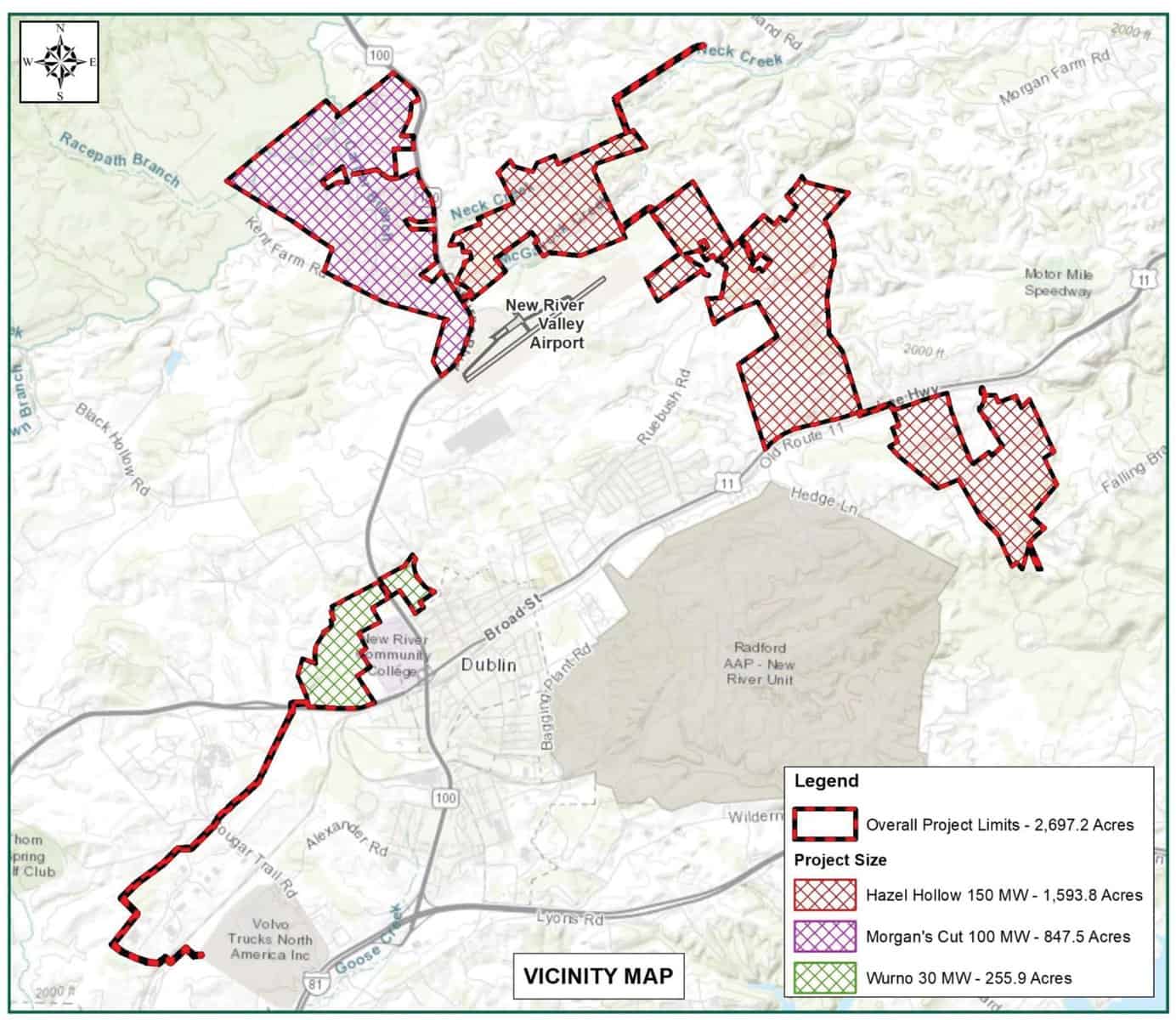Firm seeks to build solar energy project in county

Hecate Energy LLC, a developer, owner and operator of renewable power projects in North America, is seeking a Special Use Permit (SUP) for a proposed solar renewable energy generation project in Pulaski County.
According to the county’s Elaine Holeton, Planning and Zoning Director the project area covers some 2,697 acres on multiple parcels, generally located near the Town of Dublin.
Countians wanting to learn more on the project can attend an informational meeting to be held from 7 to 9 p.m. on Dec. 1 in Pulaski County High School’s Little Theater. More on the meeting can be found in this week’s issue in a legal notice in our Classified section.
 According to Holeton, a preliminary concept of the project was presented to the Pulaski County Planning Commission last week. Planners will hold a public hearing on Hecate’s SUP application at 7 p.m. on Jan. 12.
According to Holeton, a preliminary concept of the project was presented to the Pulaski County Planning Commission last week. Planners will hold a public hearing on Hecate’s SUP application at 7 p.m. on Jan. 12.
The Board of Supervisors will consider the matter, along with a public hearing on Jan. 25 at 7 p.m.
Hecate – pronounced HEK-uh-tee – is proposing to construct a 280 megawatt solar project in the county in three phases. According to Jay Poole of Hecate, the total investment in the project is anticipated to be in excess of $400 million. According to Poole, it would be one of the largest capital investments in the history of the region.
According to information provided by Holeton, the project will generate 130 new jobs during the construction phase.
It is anticipated the project will generate some $392,000 annually in new additional tax revenue for the county and total tax revenue of $13.7 million over the 35-year life of the project.
 According to Poole, employees constructing the project will pump tens of thousands of dollars into the local economy during construction.
According to Poole, employees constructing the project will pump tens of thousands of dollars into the local economy during construction.
Poole noted he believes the solar project should be viewed by countians as “an integral piece of a broader economic development strategy.”
“Approval of this project instantly makes Pulaski a player in the high-stakes game of Data Center recruitment. Companies which build Data Centers and other high-tech companies which demand sufficient quantities of renewable energy, go to places which make renewable energy more available,” Poole noted.
Poole said if the project is eventually approved by the Board of Supervisors, the next step is a review by the state’s Department of Environmental Quality. A process, he said, typically takes 5-6 months.
Poole said the DEQ review is undertaken to assure that concerns regarding water quality, screening the project so neighbors don’t have to see it, impact on local transportation patterns, noise mitigation and decommissioning of the facility itself, etc. are completely and adequately addressed by the developer.
Actual construction of the facility will begin soon thereafter – in the June-August time frame and it will probably take 10-12 months until the project is up and running, Poole noted.
“It is important to note that strenuous regulatory processes are in place and followed to the letter by local and state agencies for solar siting projects,” Poole stated. “Landowners, neighbors and other stakeholders can have confidence that every aspect of the project is thoroughly reviewed prior to approval. No short cuts are taken and safety and resource protection is an integral part of this process.”
The entire project is divided into three individual projects. Each, Poole explained, is named according to the American Electric Power-designated names of the substations to which the electrical power generated by the solar generation facility will be tied in the existing energy infrastructure.
The Wurno project is a 30-megawatt project covering 256 acres and is located immediately to the west and north of New River Community College.
The Morgan’s Cut project is a 100-megawatt project covering 848 acres located to the left of Route 100 in an area roughly spreading from New River Valley Airport to near the Giles County line.
The Hazel Hollow project is a 150-megawatt project in three chunks of land. One being located north of the airport in the McGavock Creek Road and Neck Creek area. A second area is off Route 11 stretching to the north and east of Ruebush Road. A third area if off Old Route 11 and Lee Highway southeast toward Falling Branch Road.
If the project is eventually approved, Poole said the two larger projects – Hazel Hollow and Morgan’s Cut – would likely be constructed concurrently, with the Wurno project following along six to eight months later. Poole said the Wurno project includes acreage within the Town of Pulaski, which he said is progressing on a separate track.
Poole said the acreage included in the project is agricultural – mostly pasture and hay fields – with some small, wooded areas.
“Some of the acreage in the project cannot be used for solar purposes, as it may be too steep, too rocky, too near streams and wetlands, etc. Our landowner partners will still be able to farm the land which is not inside the fence of the solar facility itself,” Poole said.
He noted that Hecate will be leasing the land from landowner partners.
Poole noted that protection of the viewshed is one of Hecate Energy’s highest priorities.
“Every step that can be taken will be taken to assure that large, planted trees, native grasses, the natural topography of the land, and native woodlands which already exist will provide a natural barrier to the facility itself. And unlike large, metal buildings in the area which are sometimes taller than surrounding homes, the solar panels themselves will be hidden from view to the greatest extent possible,” he said.
Poole described how power generated by the solar farm would make its way to the electrical grid.
“Within the solar facility itself, THERE WILL BE NO ABOVE GROUND POWERLINES BUILT. PERIOD. Electricity captured will flow through newly created power lines buried in insulated cables in the ground. All the solar energy generated from the facility will flow through these underground lines to a central point within each project. From there, the power will be uploaded to 35KV power lines, which are already in wide use in the area around the proposed facility. Those above ground lines will carry the newly captured solar energy to the three substations and tie into existing 138KV power lines at the substation,” Poole explained.
“Put simply, any concerns about tall metal towers, placed on large concrete slabs, with large power lines on this project are totally unfounded,” he added.
“AgriSunPower, Hecate Energy’s Virginia affiliate, is a homegrown company. One of ASP’s associates grew up in both Pulaski and Wythe counties, living his high school years in Pulaski. Another associate was raised on a farm in Wythe County and has known some of the landowners since he was at Virginia Tech in the 70’s. The CEO of AgriSunPower has lived in Virginia for 40 years and was a member of Virginia’s climate commission.
“None of us would be involved in a project like this unless we were 100 percent sure of the safety and efficacy of this project. I’m confident our partner landowners feel exactly the same way,” Poole said.
“Both Hecate and ASP are every bit as concerned about safety and doing this project the right way as are the people who live near the project. It is important for the people of Pulaski County to be fully informed of the facts.
- The solar panels which will be used on this project are Crystalline Silicon Panels. Silicon and steel are the predominant materials in solar panels, and the predominant material in silicon is … SAND. A solar panel is very much like a windshield – there are layers of silicon and plastic which are encapsulated by glass to prevent shattering during a hail storm, for example. Concerns about leeching into the ground, groundwater and well water contamination, are simply unfounded.
“The kind of solar panels which will be used on this project are already in broad use within the New River Valley. Think about solar panels at Radford Carilion Hospital, at Volvo, on residences all over the Valley, on lots of buildings and garages at Virginia Tech and Radford University, on buildings in the Town of Pulaski. Landowners can rest assured that Crystalline Solar panels are safe.
- Any concerns about EMF – radiation – are totally unfounded. There is NO negative impact from the generation of electromagnetic fields. Someone outside the fence of the fenced perimeter of a facility is not exposed to significant EMT from that facility. The amount of exposure is so low, it is even difficult to measure.
“Consider this example. We all use the microwave ovens in our households and don’t think twice about it. The average EMF exposure to a human while a microwave oven is operating is ten times greater than the exposure to a human standing outside the fence of one of our energy generation facilities.
“In other words, concerns about EMF/radiation are simply unfounded,” Poole said.
“The state of North Carolina is several years ahead of Virginia in terms of solar energy generation. Virginia Tech’s counterpart in North Carolina, North Carolina State University, conducted its own exhaustive research into the Health and Safety aspect of Solar farming. The conclusive findings assembled in this report clearly show that there is no factual basis for some of the concerns which are being raised by landowners who are near the proposed facilities. It is understandable that area citizens might hear all kinds of things about a project like this. We strongly encourage them to take a look at this study and the link to the study is attached below.
Poole acknowledged that 136 acres of the project near New River Valley Airport was removed from the project following a glint/glare analysis commissioned by the airport authority.
“The removal of these acres was not required by the Federal Aviation Administration, but we believed a better approach was to remove even the smallest concerns that anyone might have regarding the safety of airport operations,” Poole said.
By MIKE WILLIAMS, The Patriot



January 12, 2021 @ 3:12 pm
I am wondering how vegetation growth under the panels will be controlled. Mowing? Herbicides? Grazing?